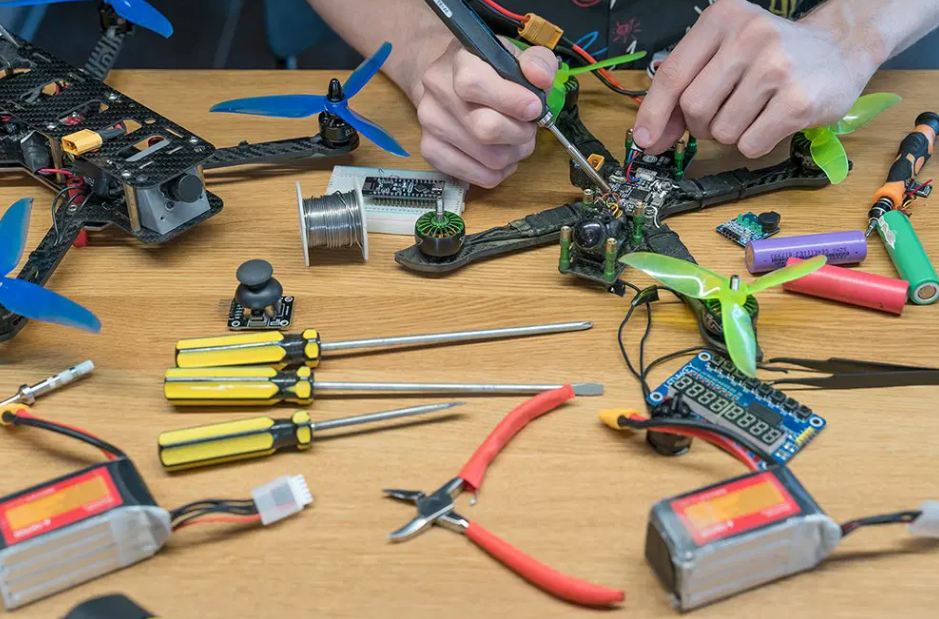Choosing the right 2306 drone motor is key to getting the best performance out of your FPV drone. In this article, we’ll cover the important factors to consider when picking a 2306 motor, including size, weight, KV rating, and price. We’ll also review some top 2306 motors from popular brands like MEPSKING, Emax, and XING-E Pro, to help you find the best motor for your flying style. Whether you’re into freestyle, racing, or just cruising, this guide will help you make the right choice for your drone.
1. The Size of 2306 Drone Motor for FPV
In FPV drone motors, the size is defined by a four-digit number, such as 2306, where:
- 23mm is the stator width (diameter), determining how much torque the motor can generate.
- 6mm is the stator height, which influences the motor’s responsiveness and cooling.
The stator is the stationary core of the motor, where the poles—thin metal plates wrapped in copper wires—produce electromagnetic forces to drive the rotor. The dimensions of the stator play a key role in shaping the motor’s behavior and suitability for specific flying styles.
2 What Makes the 2306 Drone Motor Stand Out?
2.1 Torque and Thrust Production
The 23mm wide stator provides excellent torque, making the 2306 motor capable of spinning larger propellers with ease. This is ideal for freestyle pilots who need precise control during flips, rolls, and tight maneuvers. The motor’s wider design ensures stable thrust and smooth handling, even under heavy loads, such as carrying a GoPro or similar payload.
2.2 Responsiveness
The 6mm stator height makes 2306 motors slightly less responsive than taller motors like 2207. However, this trade-off brings smoother, more predictable performance, which is favored by freestyle pilots who prioritize flow and control over rapid acceleration.
2.3 Cooling Efficiency
A wider stator like 2306 naturally dissipates heat better than taller, narrower motors. The increased surface area helps keep temperatures lower during intense flying sessions, maintaining efficiency and preventing performance loss. This is particularly beneficial for extended flights or when flying in hot environments.
2.4 All-Around Versatility
The 2306 motor size strikes a balance between power, control, and efficiency, making it an excellent choice for 5-inch FPV drones. It is versatile enough to cater to various flying styles, from smooth freestyle to casual racing, and works well with both 4S and 6S batteries.
3 Key Factors to Consider When Choosing a 2306 Drone Motor for FPV
3.1 Weight
The weight of a motor is a crucial factor when selecting a 2306 motor for FPV drones, especially for high-performance applications like freestyle and racing. Motors are mounted at the far ends of a drone’s frame, meaning any additional weight directly affects how quickly the drone can change direction. Lighter motors make a drone more agile, allowing for faster flips, rolls, and precise movements. On the other hand, heavier motors can slow down the drone’s response time because they require more effort to accelerate and decelerate during rapid maneuvers.
For freestyle pilots who value smooth, flowing tricks, a slightly heavier motor can offer more stability in the air. However, for racing, where every millisecond counts, a lightweight motor ensures the drone remains highly responsive. Striking the right balance in motor weight is essential to match your flying style and performance goals.
FOR MORE INFORMATION CLICK HERE : valentines day gifts for husband
3.2 KV Rating
KV, or “RPM per volt,” is one of the most important considerations when selecting a 2306 motor. It directly influences the motor’s speed, torque, and overall efficiency. A higher KV motor spins faster at the same voltage, providing greater speed and power. However, this comes at the cost of increased current draw, which can reduce efficiency and strain your battery. For freestyle pilots, a medium to lower KV (e.g., 1700-2000 KV for 6S batteries) offers smoother control and better torque, ideal for technical tricks and stability during maneuvers. For racing, where speed and acceleration matter more, higher KV motors (e.g., 2400-2700 KV for 4S batteries) deliver the rapid response needed for tight turns and straights. It’s important to balance KV with your propeller size and battery. Larger props generally pair better with lower KV motors to avoid excessive current draw, while smaller props work well with higher KV motors for quick, snappy performance. Matching the KV to your flying style and setup ensures you get the best performance without compromising efficiency or battery life.
3.3 Price vs. Performance
When choosing a 2306 drone motor, finding the right balance between price and performance is crucial. High-end motors often feature premium materials, such as titanium shafts and high-quality bearings, which improve durability and efficiency. They may also have tighter manufacturing tolerances, ensuring smoother performance and more consistent quality. However, these motors can be significantly more expensive.
Budget-friendly options, on the other hand, may sacrifice some durability or efficiency but can still deliver excellent performance for most pilots, especially beginners or those who don’t need the absolute best. It’s important to evaluate your flying style and needs—if you’re a competitive racer or freestyle pilot, investing in high-quality motors could be worth it for their reliability and precision.
For casual pilots or those learning the ropes, affordable motors can still offer plenty of power and fun without breaking the bank. Always check reviews and test data to ensure you’re getting the best value for your money in the 2306 size.
4 Top 2306 Drone Motors for FPV in 2024
4.1 2306 Drone Motor from MEPSKING
I’ve been using the MEPS SZ2306 motor on my 5-inch FPV drone, and it’s been a great experience so far. Here’s what I’ve noticed after flying with the 2306 drone motor:
- Performance – The power is impressive, and the N52H arc magnets provide excellent thrust. It feels smooth and responsive, especially during sharp turns and quick recoveries. Even at high throttle, the motor stays cool and efficient.
- Durability – This motor is built to last. The titanium alloy shaft and NMB bearings are strong and reliable, handling crashes without any issues. The use of high-temp copper wire is also a big plus, making it dependable during long, hard flights.
- Design – I love the sunflower-style Uni-Bell design—it’s lightweight and looks amazing. The bright fluorescent green color is eye-catching and makes it easy to spot your drone.
- KV Options – I chose the 1950KV version for my 6S setup, and it offers a great mix of power and control. If you’re on 4S, the 2450KV might be a better fit for faster flying.
The MEPS SZ2306 motor is perfect for freestyle. It’s powerful, durable, and affordable, making it a solid choice for any FPV pilot. I highly recommend it for anyone looking to upgrade their 5-inch build.
4.2 Emax RSII 2306 Motor
I recently had the chance to try out the Emax RSII 2306 motor, and here’s my honest take on it. At $25 per motor, it’s definitely on the pricier side, but after flying with it, I can say it’s well worth the investment.
One of the standout features is the lightweight design—weighing in at just 29 grams, the RSII 2306 feels surprisingly light for its size. Emax has done an excellent job reducing weight without sacrificing strength. The motor feels solid in hand, and you can tell it’s built to last. The precision engineering ensures smooth, consistent performance with minimal vibrations.
When it comes to performance, this motor really delivers. It handles high amp draws with ease, even during aggressive maneuvers, and provides plenty of power when needed. The RSII 2306 feels smooth and responsive, whether you’re cruising or pushing your drone to its limits. It’s perfect for those looking for power without compromising on efficiency.
The wide range of KV options makes this motor versatile. I tried it on both 4S and 6S setups, and the motor handled both with ease. The lower KV versions are great for larger 7-inch props or those looking to push higher voltage setups on 6S. The variety ensures that it suits different types of flying, whether you’re racing, cruising, or doing freestyle.
4.3 XING-E Pro 2306 4S 6S FPV Motor
I recently tried the XING-E Pro 2306 motor and was really impressed with its performance. The build quality is top-notch, featuring a 5mm steel shaft and CNC machined aluminum parts that feel solid and durable. This motor can handle tough flights, and the M3 shaft screw ensures everything stays securely in place.
In terms of performance, the N52SH magnets provide plenty of power, and I used it on both 4S and 6S setups without any issues. It delivers smooth, responsive thrust, making it great for both freestyle and racing. The NSK bearings make the motor run smoothly with minimal vibrations, so it responds quickly when I’m pushing the limits.
For its performance, the XING-E Pro 2306 is also quite affordable, offering a lot of value for the price. It’s a great choice for anyone looking for a reliable and powerful motor without breaking the bank. Whether you’re a beginner or an experienced pilot, this motor won’t disappoint. Highly recommended!

